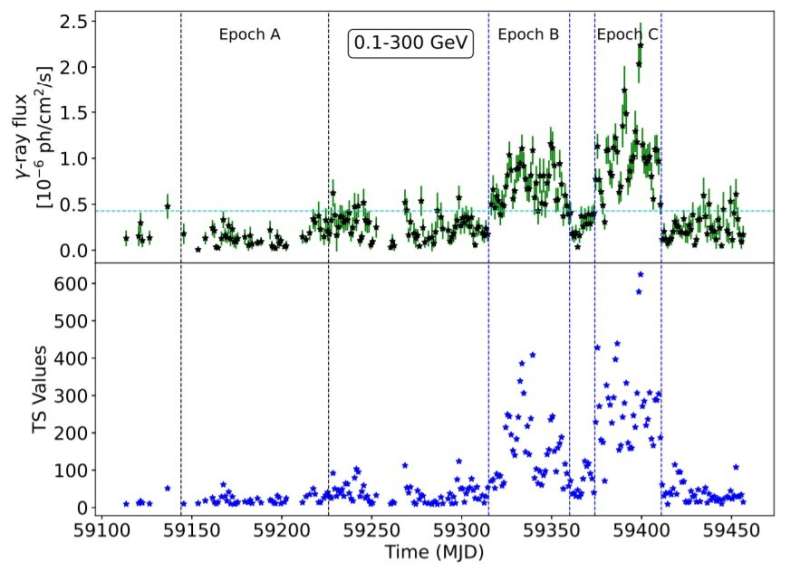One-day binned gamma-ray light curve of Ton 599 (upper panel) with the test statistics (TS) values corresponding to each flux value (lower panel). Credit: Rajput and Pandey, 2021.
Using NASA's Fermi spacecraft, researchers from the Indian Institute of Astrophysics in Bangalore, India, have conducted a gamma-ray flux and spectral variability study of a blazar known as Ton 599, during its recent flaring activity. Results of the research, published December 13 on the arXiv pre-print server, shed more light on the properties of this source.
Blazars are very compact quasars associated with supermassive black holes (SMBHs) at the centers of active, giant elliptical galaxies. They belong to a larger group of active galaxies that host active galactic nuclei (AGN), and are the most numerous extragalactic gamma-ray sources. Their characteristic features are relativistic jets pointed almost exactly toward the Earth.
Based on their optical emission properties, astronomers divide blazars into two classes: flat-spectrum radio quasars (FSRQs) that feature prominent and broad optical emission lines, and BL Lacertae objects (BL Lacs), which do not.
At a redshift of 0.725, Ton 599 (also known as 4FGL J1159.5+2914) is a strongly polarized and a highly optically violent variable FSRQ. In 2017 it went through a protracted flaring condition spanning the full electromagnetic spectrum. More recently, from July to September 2021, the quasar exhibited a bright flare in gamma-rays.
Bhoomika Rajput and Ashwani Pandey decided to observe Ton 599 using Fermi when it entered its recent flaring state, with the aim of investigating the blazar's gamma-ray emission process and its consequences during the flaring condition.
"We present here the results of our γ-ray flux and spectral variability study of the blazar Ton 599, which has been recently observed in the γ-ray flaring state," the researchers wrote in the paper.
From the Fermi data, Rajput and Pandey generated a one-day binned light curve of Ton 599 for a period of about one year (September 2020-August 2021). The final gamma-ray light curve contains 256 confirmed measurements of this blazar. For this period, the maximum gamma-ray flux detected was at a level of 0.00000224 ph/cm2/s.
Based on the observations, the astronomers identified three epochs of different flux states of Ton 599: quiescent, pre-flaring, and main-flaring. The largest gamma-ray flux variations were found for the main-flaring epoch (about 0.35 percent), while during the pre-flaring epoch, the source exhibited variations at a level of 0.22 percent. However, no significant flux variation was detected in the quiescent epoch.
The researchers found that the log parabola (LP) model best describes the gamma-ray spectra of Ton 599 during all the three epochs. This indicates that the GeV gamma-ray spectrum of this blazar is curved.
The authors of the paper also estimate that the size of the gamma-ray emitting region is approximately 103 billion kilometers. They added the location of the gamma-ray emitting blob of Ton 599 could be outside its broad line region (BLR).
More information: Bhoomika Rajput, Ashwani Pandey, γ-ray Flux and Spectral Variability of Blazar Ton 599 during Its 2021 Flare. arXiv:2112.06681v1 [astro-ph.HE], arxiv.org/abs/2112.06681
© 2021 Science X Network
























